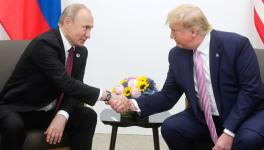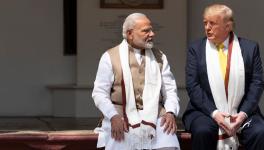Coronavirus Reveals the Cracks in Globalization

The coronavirus will eventually pass, but the same cannot be said for the Panglossian phenomenon known as “globalisation.” Stripped of the romantic notion of a global village, the ugly process we’ve experienced over the past 40 years has been a case of governmental institutions being eclipsed by multinational corporations, acting to maximise profit in support of shareholders. To billions of us, it has resembled a looting process, of our social wealth, and political meaning. Governments that wanted to stay on top would have to learn to master soft power to learn to be relevant in a globalised world, mostly acting to smooth transactions and otherwise stay out of the way.
In a globalised world, nation-states were supposedly becoming relics. To the extent that they were needed, small national governments were said to equate to good government. This hollow philosophy’s main claims now appear badly exposed, as the supply chains wither, and the very interconnectedness of our global economy is becoming a vector of contagion. In the words of author David Goodhart, “We no longer need the help of rats or fleas to spread disease—we can do it ourselves thanks to mass international travel and supply chains.”
To be sure, there were many warning signs that called into question our hitherto benign assumptions about globalisation: the Asian financial crisis of 1997-98 (during which the Asian tiger economies were decimated by unconstrained speculative capital flows), the vast swaths of the Rust Belt’s industrial heartlands created by outsourcing to China’s export juggernaut, the concomitant rise in economic inequality and decline in quality of life in industrialised societies and, of course, the 2008 global financial crisis. Nobel laureate Joseph Stiglitz described many of these pathologies in his book Globalization and Its Discontents, as did economist Barry Eichengreen, who lamented that “the nation state has fundamentally lost control of its destiny, surrendering to anonymous global forces.” Both noted that globalisation was severing a working social contract between national governments and their citizens that had previously delivered rising prosperity for all.
Those who would argue that the inexorable march of globalisation cannot be reversed should consider the parallel during the early 20th century. Globalized economic activity and free trade were dominant before the onset of World War I; in 1914, trade as a proportion of global GDP stood at 14 percent. Needless to say, two world wars, and the Great Depression (which brought us the Smoot-Hawley tariffs), reversed this trend. The Cold War sustained regionalisation and bifurcated trading blocs. Its end, and China’s accession into the World Trade Organisation (WTO), ushered in a new high-water mark in globalised trade.
But while it is true that viruses do not respect national boundaries, nothing has blown apart the pretensions of this New World Order as dramatically as the coronavirus, a pandemic now assuming global import, as international supply chains are severed, and global economic activity is brought to a screeching halt. We are increasingly seeing the hollow political content at the core of supranational entities such as the EU, structured more to comfort merged investor groups than strengthen public health systems.
Speaking of Europe, while the coronavirus started in China, its most long-lasting impact might be in the EU, as it has dramatically exposed the shortcomings of the latter’s institutional structures. Take Italy as the most vivid illustration: The spread of COVID-19 has been particularly acute there. Being a user of the euro (as opposed to an issuer of the currency) the Italian national government risks exposing itself to potential national bankruptcy (and the vicissitudes of the volatile private capital markets) if it responds with a robust fiscal response, absent the institutional support of Brussels and the European Central Bank (which is the sole issuer of the euro). According to MarketWatch, “Italy needs a €500 to €700 billion ($572 billion to $801 billion) precautionary bailout package to help reassure financial markets that the Italian government and banks can meet their debt payment obligations as [the] country’s economic and financial crisis becomes more fearsome.”
The tragic case of Italy (where the entire country is now in full quarantined lockdown) provides a particularly poignant example of the gaping lacunae at the heart of the eurozone. There is no supranational fiscal authority, so the Italian government has been largely left to fend for itself, as it is trying to do now, for example, providing income relief by suspending payments on mortgages across the entire country. Here is a perfect example of where European Central Bank support for the Italian banking system would go a long way toward mitigating any resultant financial contagion. But so far, as Wolfgang Munchau of the Financial Times has noted, the ECB remains in “monitoring” mode. Indeed, the eurozone as a whole lacks the institutional mechanisms to mobilize on a massive, coordinated scale, in contrast to the U.S. and UK, and eurozone finance ministers remain incapable of agreeing on a coordinated policy response.
Other eurozone countries may no longer be complacent about the threat posed by COVID-19, but their national governments are more focused on the need to stockpile their own national resources to protect their populations. Italy remains particularly vulnerable to the ravages of this virus, as it has an aging population, so if coronavirus runs rampant through the country, it could potentially crash the nation’s entire hospital system, as this account by an Italian doctor suggests.
EU solidarity, showing cracks on issues ranging from finance to immigration, increasingly resembles every country for itself.
Defenders of the EU may well retort that health care is designated as a “national competency” under the Treaty of Maastricht. But how does one expect national competencies to be carried out competently in an economic grouping devoid of national currencies (the key variable as far as supporting unconstrained fiscal capacity goes)? Additionally, the evil of decades of Brussels-imposed austerity has meant there aren’t enough hospital beds, materials and staff anywhere in Europe, let alone Italy. This might well represent the death knell for a European project based on aspirations for an “ever closer union.”
In spite of the manifest incompetence of the Trump administration, the U.S. at least has institutional mechanisms in place via the Centers for Disease Control (CDC) and the Federal Emergency Management Agency (FEMA) to provide Americans with clear, credible instructions devoid of political spin. As Professor James Galbraith has persuasively argued, the U.S. government has the capacity to “establish a Health Finance Corporation on the model of the Depression-era Reconstruction Finance Corporation. Like the RFC, which built munitions factories and hospitals during and after World War II, the HFC should have broad powers to create public corporations, lend to private companies (to fund necessary production), and cover other emergency costs. Even more quickly, the National Guard can be deployed to deal with critical supply issues and to establish emergency facilities such as field hospitals and quarantine centers.” Likewise, Senator Marco Rubio has “sought to expand what’s called the Economic Injury Disaster Loan program, which allows the Small Business Administration to start lending money directly instead of just encouraging banks to do so,” as Matt Stoller has written. Parenthetically, this represents a marked break with historic GOP policy, which for the most part has accepted the embedded assumptions inherent in globalisation.
And while traditional monetary policy tools such as interest rate cuts are hardly adequate to stem a supply shock, Galbraith also points to the ability of the Federal Reserve to offer emergency financial support to help American companies through the worst of the coronavirus outbreak, by “buy[ing] up debt issued by hospitals and other health-care providers, as well as working to stabilize credit markets, as it did in 2008-09.” Andrew Bailey of the Bank of England has made similar recommendations to the UK government.
Even with the measures proposed by Galbraith, Bailey and Rubio, virtually all Western economies, having largely succumbed to the logic of globalization, are now vulnerable, as supply chains wither. China, the apex of these offshored manufacturing supply chains, is in shutdown mode. Likewise South Korea and Italy. Worse, there appears to be a singular lack of understanding on the part of many multinational companies as to how far these supply chains go: “Peter Guarraia, who leads the global supply chain practice at Bain & Co, estimated that up to 60 per cent of executives have no knowledge of the items in their supply chain beyond the tier one group,” reports the Financial Times.
A “tier one” company supplies components directly to the original equipment manufacturer (OEM) that sets up a global supply chain. But as is now becoming increasingly recognized, there are secondary-tier companies, which supply components or materials to those tier-one companies. When goods are widely dispersed geographically (instead of centered in a localised industrial ecosystem), it is harder for executives to have full knowledge of all of the items in their respective companies’ supply chains, so the deficiencies of the model only become apparent by the time it is too late to rectify.
In the U.S. specifically, the mass migration of manufacturing has seriously eroded the domestic capabilities needed to turn inventions into high-end products, damaging America’s ability to retain a lead in many sectors, let alone continue to manufacture products. The country has evolved from being a nation of industrialists to a nation of financial rentiers. And now the model has exposed the U.S. to significant risk during a time of national crisis, as the coronavirus potentially represents.
There is no national redundancy built into current supply networks, with the most problematic consequences now evident in the pharmaceutical markets. Countries such as China or India are beginning to restrict core components of important generic drugs to deal with their own domestic health crisis. This has the potential to create a major crisis, given that the U.S. “depend[s] on China for 80 percent of the core components to make our generic medicines,” writes Rosemary Gibson in the American Conservative. She also notes that “generic drugs are 90 percent of the medicines Americans take. Thousands of them, sold at corner drug stores, grocery store pharmacies, and big box stores, contain ingredients made in China.” Constraints on production, therefore, intensify as more and more of the manufacturing process pertaining to the drugs themselves is geographically globalised. And in regard specifically to research-intensive industries, such as pharmaceuticals or biotech, the value of closely integrating the R&D with manufacturing is extremely high, and the risks of separating them are enormous.
These are by no means new problems. We’ve been dealing with supply-side shocks emanating from hyper-globalisation for decades, and the response of Western policymakers has largely been in the form of fiscal or monetary palliatives that seldom address the underlying structural challenges raised by these shortages. To the contrary: democratic caveats to globalisation have been characterised as inefficient frictions that hinder consumer choice.
For now, we should start by reducing our supply chain vulnerabilities by building into our systems more of what engineers call redundancy—different ways of doing the same things—so as to mitigate undue reliance on foreign suppliers for strategically important industries. We need to mobilise national resources in a manner akin to the way a country does during wartime or during massive economic dislocation (such as the Great Depression)—comprehensive government-led actions (which runs in the face of much of today’s prevailing and increasingly outdated economic and political theology). In other words, the revival of a coherent national industrial policy.
To save the global economy, paradoxically, we need less of it. Not only does the private/public sector balance have to shift in favor of the latter, but so too does the multinational/national matrix in manufacturing. Otherwise, the coronavirus will simply represent yet another in a chain of catastrophes for global capitalism, rather than an opportunity to rethink our entire model of economic development.
Marshall Auerback is a market analyst and commentator.
This article was produced by Economy for All, a project of the Independent Media Institute.
Get the latest reports & analysis with people's perspective on Protests, movements & deep analytical videos, discussions of the current affairs in your Telegram app. Subscribe to NewsClick's Telegram channel & get Real-Time updates on stories, as they get published on our website.
























